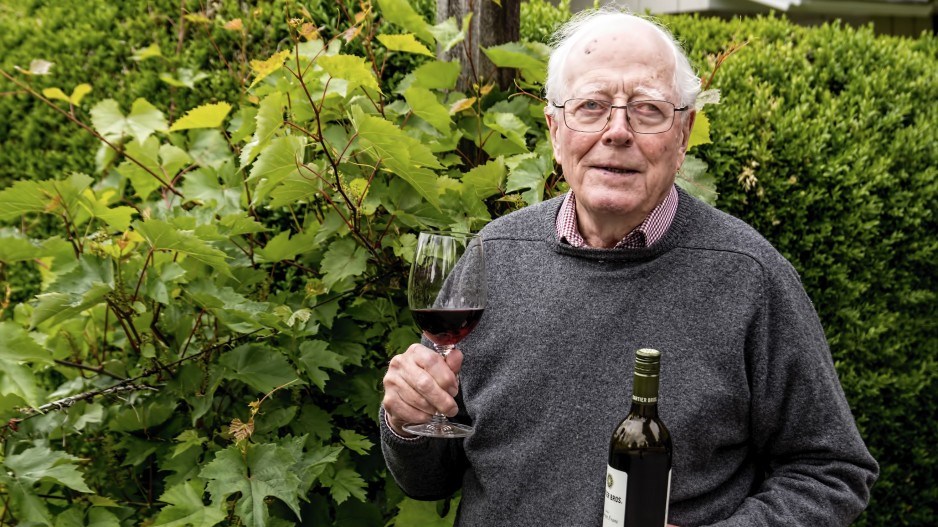Many people think of heat domes stunting grape harvests when they hear that climate change is affecting B.C.’s wine sector.
Some also think of forest-fire smoke clinging to grape skins, thereby tainting the taste of future wines and rendering the products worthless.
B.C. wine industry players are now realizing that a bigger climate-change effect could be winter deep-freezes, where Arctic air drifts down and plunges temperatures to -30 C.
Air that cold kills grape vines and winery owners are grappling with that this year.
Thirty-eight landowners who produce 59 per cent of the province’s wine grapes responded to a Wine Growers BC (WGBC) survey in late May and early June. They projected that their total grape and wine production this year would be 54 per cent less than the production level of a typical year.
They also estimated that 43 per cent of planted acreage would endure long-term damage.
A 43-per-cent revenue reduction in B.C. wine revenue would shave $341 million off a sector that WGBC says contributed $793 million to the B.C. economy in 2019.
Vineyard and winery owners would bear $133 million of that lost revenue, the WGBC said in a June report.
Many B.C. wine regions endured unusually cold weather for an extended spell in December 2022. Temperatures remained below -20 C for many days in most parts of B.C.’s Interior and they reached as low as -30 C in Kelowna, West Kelowna and the Shuswap region.
If those conditions do not kill grapevines, they significantly damage them, impacting yields in the short-term and long-term.
“There’s two sides to the coin,” WGBC CEO Miles Prodan told BIV.
The wine industry in recent decades has focused largely on the spectre of raging forest fires and hotter weather.
Painted Rock Estate Winery owner John Skinner told BIV in August 2020 that forest fires forced him to close his winery and that he was scared it would burn to the ground.
He was grateful for water bombers that saved the day.
Forest fires in 2003 surrounded Cedar Creek Estate Winery, forcing owners to dispose of the winery’s celebrated Pinot Noir harvest that year.
The new fear is severe cold in winter, Prodan said.
A Summerland Research and Development Centre study, released before the WGBC’s survey, forecast a similar ravaged grape harvest this year as a result of severe cold in late 2022. It estimated that B.C.’s wine-grape harvest this year would be between 39 per cent and 56 per cent smaller than a normal year. It did not attempt to estimate the long-term damage.
Prodan is lobbying the provincial government to provide financial support to winery and vineyard owners hit hard by cold this past year. That is what the Nova Scotia government is doing.
Nova Scotia in March announced a program with $15 million to support grape and fruit growers whose crops were affected in February by extreme cold weather in that province.
Prodan praised the B.C. government for newly allowing grape farmers to apply for provincial compensation when they pull out varieties vulnerable to the changing climate and plant hardier ones.
Wine-guide author John Schreiner spoke to BIV by phone while travelling between Osoyoos and Oliver.
“There are new plantings all over the place from vineyards that were frozen out last November and December,” he said.
“A lot of vines were killed off and those that weren’t killed and are still growing – you see them in the vineyard with a negligible amount of fruit.”
Syrah is one grape variety particularly averse to severe cold, he said.
Schreiner suggested that owners at B.C. wineries that grow Syrah grapes, such as Le Vieux Pin, Rust Wine Co., and Mt. Boucherie Estate Winery, might think about pulling out those vines and planting Cabernet Franc grapes, which are hardier.
A University of British Columbia study in 2020 focused on warming temperatures in wine regions.
It noted that “half of current global wine-growing regions would become climatically unsuitable for today’s major wine grapes” if temperatures were to rise by more than two degrees.
“Substituting Grenache or Cabarnet Sauvignon for Pinot Noir, planting Trebbiano where Riesling is grown – these aren’t painless shifts to make, but they can ease winegrowers’ transition to a new and warmer world,” said the study’s senior author, Elizabeth Wolkovich.
Another trend Schreiner has noticed is cooler springs.
Spring 2022 was cold and rainy, causing winemakers to fear a stunted season. The Okanagan then enjoyed a warm autumn, enabling the grapes to hang on vines into October.
The vines then had little time to shut down before being blasted with severe winter cold.
“The vines weren’t ready for it,” Schreiner said.
Winery consultant and InVino Consultants principal Ingo Grady agreed with Schreiner that winery owners will need to rethink what kinds of grapes they plant.
“Every grape variety has a climate envelope,” he said. “You really need to have the science and the knowledge of what flourishes where, but after this last winter, there’s not a winery in this valley that hasn’t suffered losses.”

